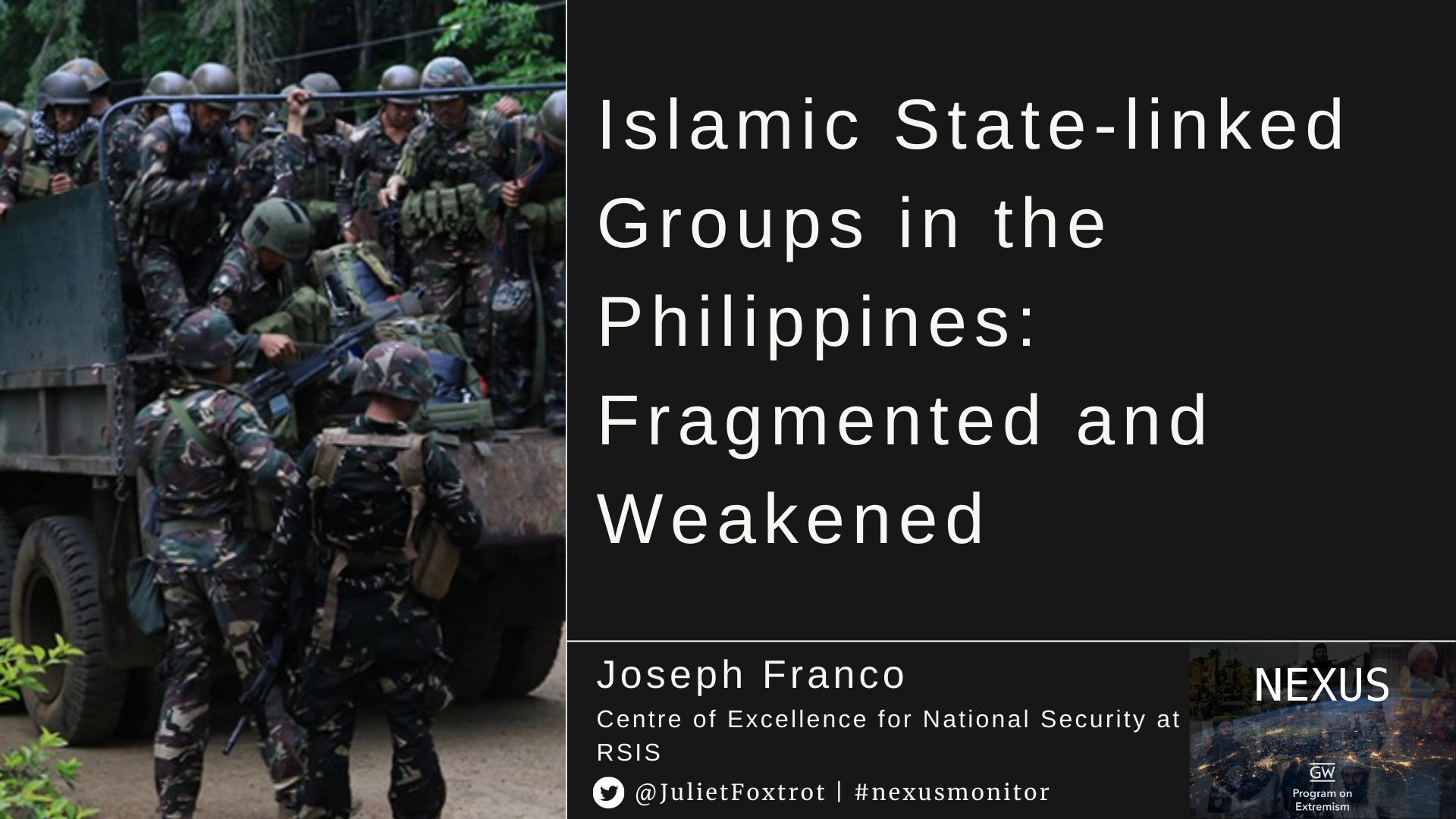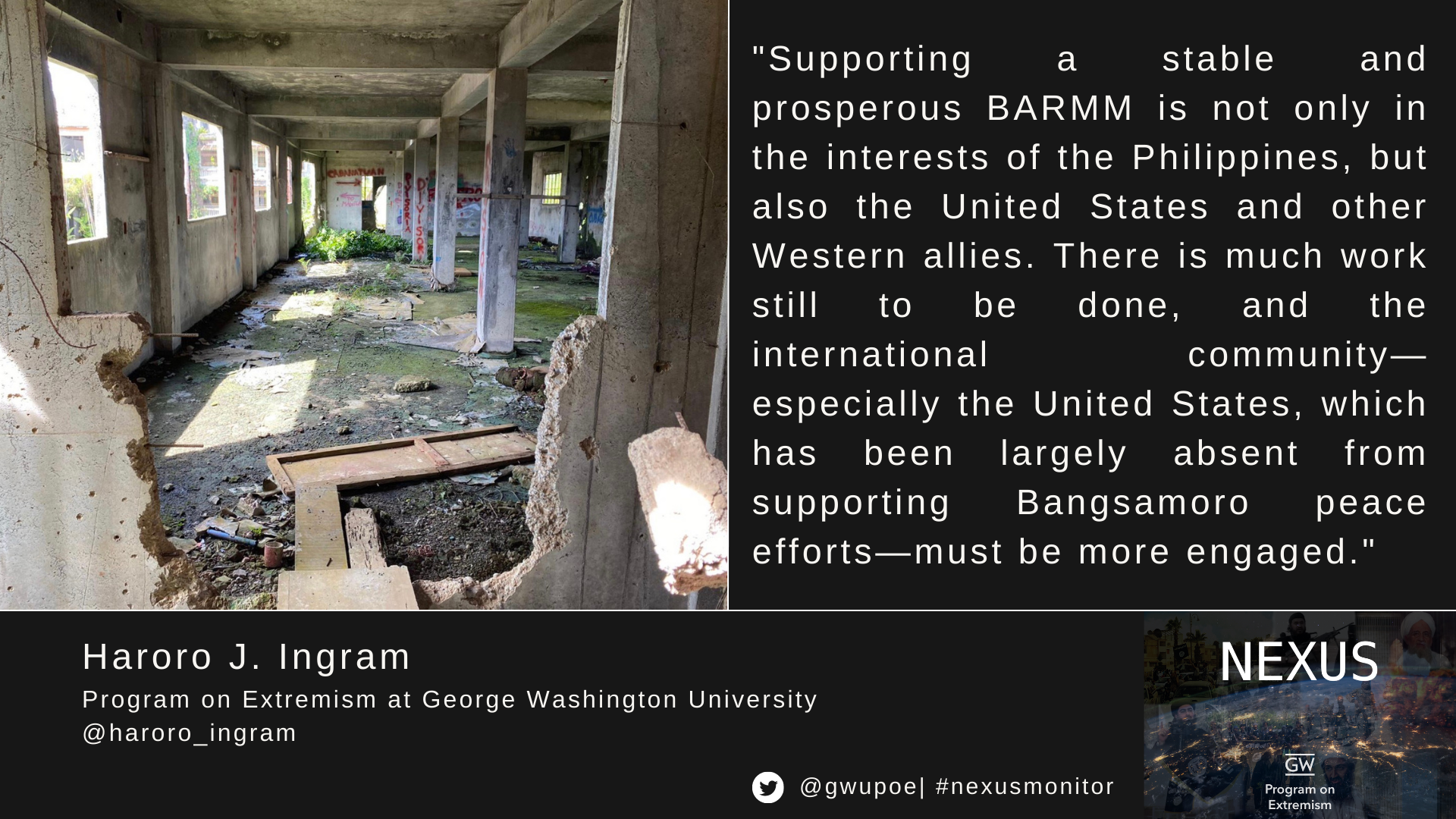THE INITIAL STAGES of the Battle for Marawi in 2017 signified the height of Islamic State (IS) influence in Mindanao. Various militant factions from the island-provinces of western Mindanao to the marshlands of central Mindanao coalesced into a fighting force that occupied the commercial heart of the Philippines’ sole Islamic city. The five-month campaign highlighted the weakness of Philippine security forces in defeating a well-entrenched force in an urban environment. On the other hand, the Battle for Marawi underscored how IS-linked groups such as the Maute Group (MG) failed to establish its vision of a wilayah (province), and was almost immediately forced to engage in a fight for survival rather than exercise governance over its areas of control. Nearly five years after the Battle of Marawi, the various IS-linked violent extremist organizations (VEOs) in Mindanao appear to have lost the initiative.
It was initially feared that the COVID-19 pandemic would trigger more violence against security forces as they were dispersed to conduct public health-related tasks such as manning checkpoints and enforcing community quarantine. Instead, movement controls and community quarantines stifled the mobility and freedom of action for VEOs. A marked downturn in violence in Mindanao from Islamist-linked groups and other non-state armed groups from 2017 appeared to have been sustained all the way into the end of 2021. It is expected that there will be an uptick in violence in Mindanao in the run up to the 2022 presidential elections. This expected surge in violence is deeply rooted in local sociopolitical dynamics, rather than the influence of jihadist ideology. This article will examine the status of IS-linked groups in Mindanao and the impact of recent developments, such as the pandemic and Philippines military operations. The impact of the upcoming national and local elections will also be explored.
IS-linked Groups in Mindanao
It must be stressed that despite years of sensationalist reporting, IS core in Iraq and Syria never deemed fit to declare a wilayah in the southern Philippine region of Mindanao. References by IS core in propaganda outfits such as Al Naba to an East Asian wilayah referred to a nebulous region encompassing Indonesia, Malaysia and the Philippines. The late Isnilon Hapilon, once the leader of Abu Sayyaf Group (ASG) factions in the island-province of Basilan, was considered the emir or leader of Philippine-based VEOs but never as a wali or governor of an official wilayah as defined by IS core.[1]
Hapilon and his allies pledged allegiance to IS between 2014 and 2016. But his stature was not fully accepted by other VEO faction leaders in Mindanao. The limits of his leadership were highlighted during the 2017 Battle for Marawi. The actual day-to-day conduct of fighting was led by the founders of the Maute Group, brothers Omar and Abdullah Maute, who hailed from Lanao del Sur’s Butig municipality, a couple of hours south of Marawi.
Hapilon and his successors based in the Philippines have not explicitly laid claim to VEO factions based in Indonesia and Malaysia. What is often referred to as Islamic State-East Asia (IS-EA) can be best described as a fragmented constellation of VEOs operating on the island and mainland provinces of Mindanao. Its purported influence in Indonesia and Malaysia are more aspirational rather than operational—given IS-EAs limited reach into those countries—when compared to the actual operational tempo of VEOs in the Philippines.
Specifically, militants in the Philippines ascribe to themselves the moniker of ‘Dawlah Islamiyah’ (DI) a translation of the phrase ‘Islamic State’. In turn, Philippine security forces, specifically the Armed Forces of the Philippines (AFP) delineate the DI factions based on leadership figures. Curiously, this naming convention seem to not apply to the ASG, with its sub-factions differentiated largely by province (Sulu and Basilan) rather than known faction leaders.
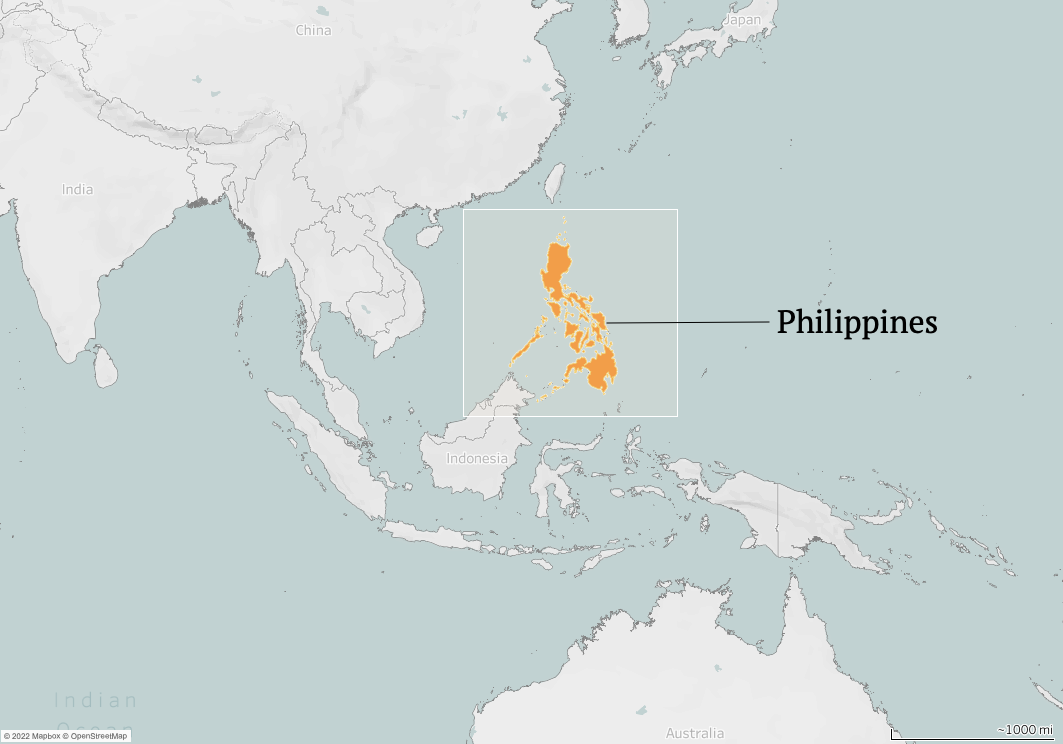
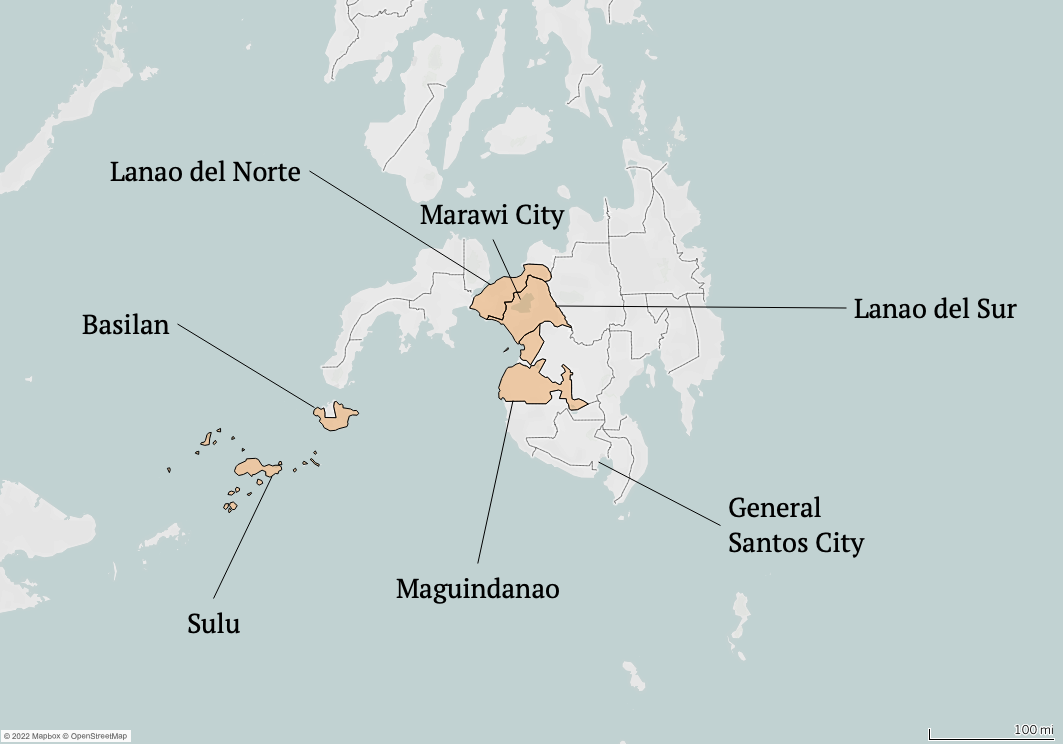
Locations of IS-linked Group Activity in the Philippines
Dawlah Islamiyah-Maute Group (DI-MG) in the Lanao Provinces
The DI-MG operates in the provinces of Lanao del Norte and Lanao del Sur, Marawi is an enclave within the latter. In the aftermath of the 2017 Battle for Marawi, the DI-MG’s leadership was passed on to Benito Marohombsar (alias ‘Abu Dar’), before he himself was killed in a March 2019 encounter. As of January 2022, the DI-MG has around 30 armed members and is led by Faharudin Hadji Satar (alias ‘Abu Zacharia’).[2]
Dawlah Islamiyah-Turaype Group (DI-TG) in Maguindanao
DI-TG was founded by Esmael Abdulmalik (alias ‘Abu Turaype’). It is estimated as of the 2nd quarter of 2021 to have around 100 followers in Maguindanao province. His faction was formerly part of the Bangsamoro Islamic Freedom Fighters (BIFF) and emerged when Turaype deemed his fellow rebel commanders as not being violent enough.[3]
Dawlah Islamiyah-Hassan Group (DI-HG) in Central and Southern Mindanao
The DI-HG traces its roots to the now defunct al-Khobar extortion gang which operated in the southern cities of Mindanao from 2007-2015. Before he was killed in 29 October 2021, Salahuddin Hassan was referred to by some sources as the emir of IS-EA or IS-Philippines after the demise of DI-MG leader Abu Dar. As of the 4th quarter of 2021, the DI-HG is currently estimated to have around 30 armed members.
Abu Sayyaf Group-Sawadjaan Group in Sulu Province
Sawadjaan Group is perhaps the most notorious of the IS-linked factions in the Philippines. It is the only ASG faction in the Philippines known to have adopted suicide bombing attacks as part of its repertoire. The group’s founder, Hajan Sawadjaan, was reported killed in a July 2020 military operation. It is widely suspected that the 2020 August Jolo cathedral bombing was conducted in retaliation for his death. The core of the Sawadjaan group is estimated to be 30-50 fighters.[4] However, during protracted skirmishes with government forces, the faction is capable of mobilizing up to 200 fighters from across Sulu province. Hajan Sawadjaan’s nephew, Mudzrimar Sawadjaan, is suspected to lead this ASG faction. At present, it is unclear if remnants of the Sawadjaan group have strong operational links to other ASG factions, the largest of which is the faction controlled by Radulan Sahiron (alias ‘Commander Putol’). Sahiron is considered part of the ‘old guard’ of the ASG, and cultivated his reputation as a Robin Hood-styled figure among some Sulu communities rather than an IS supporter.[5]
Non-Dawlah Factions in Maguindanao: The Bungos and Karialan Factions
Media reporting and other analysts often conflate the Bangsamoro Islamic Freedom Fighters (BIFF) as part of IS-EA or the other Dawlah movements in Mindanao. However, ever since the BIFF emerged in 2011 as a splinter group of the mainstream secessionist movement in Mindanao, its main factions were aligned to the idiosyncrasies of its factional leaders. Non-DI BIFF factions are also known to operate almost exclusively within the confines of Maguindanao province. The BIFF-Bungos faction led by Esmael Abubakar (akias ‘Commander Bungos’) was known to have dabbled in IS propaganda, but swiftly retracted its pledges by 2018.[6] On the other hand, the larger BIFF faction led by Mohiden Animbang (alias ‘Kagi Karialan’) was consistently committed to the ethnonationalist aspect of the BIFF’s resistance. Karialan is also known to have close familial ties with incumbent officials of the Bangsamoro Autonomous Region for Muslim Mindanao (BARMM).[7]
Decline in VEO-initiated Incidents
Overall, the years following the 2017 Marawi siege saw a continued drop in the number of violent incidents. Based on statistics from International Alert’s conflict monitoring database, violent incidents such as IED attacks and shootings declined steadily from 4,140 incidents in 2017 to 2,655 incidents in 2019. The provinces associated with DI and ASG factions—Maguindanao, Sulu, and Basilan—saw declines in deaths due to attacks by 39% in Tawi-Tawi; 20% in Basilan including the city of Isabela; 8% in Sulu; and 5% in Maguindanao including the city of Cotabato.
In the short term, violence is likely to spike as the campaign period gets underway before the May 2022 elections. In the previous presidential election cycle, local election-related violence was deemed the cause of a nearly three-fold spike in violence. Any spike in violence in areas known to house IS-linked groups should be contextualized and not automatically seen as a resurgence of jihadist related activity. It may be premature for the AFP to claim the various DI factions to be “on the brink of defeat”, but it is a claim with some merit. The killing of Salahuddin Hassan of the DI-HG followed the reported death of Hajan Sawadjaan. The haphazard manner in which the ‘emir’ tag has been shifting back and forth from factions based in Western Mindanao to Central Mindanao since 2017 signifies instability in existing bailiwicks and spheres of influence in the area.
Given the relative independence of the various IS-linked factions, any pronouncement of who is the purported emir is likely an aspirational statement rather than indicative of actual operational linkages on the ground. It must also be stressed that inter-faction relations are heavily segmented by ethnic lines. An ethnic Yakan like Hapilon had limited legitimate authority over Maranaos like the Maute brothers.[8] As another example, it is unlikely that Abu Dar from the Maranao ethnic group had meaningful control over the activities of the Sawadjaan group in Sulu after Marawi.[9]
An assessment made by the US DOD at the close of 2020 sums up the current operational tempo of the aforementioned groups, stating IS-EA will: “maintain their current level of membership and violence over the next 1 to 2 years. These groups will likely continue to conduct a steady stream of small-scale operations, primarily targeting Philippine counterterrorism forces.”
The Absence of Links and Support from IS Core
It took the emergence of IS for Filipino VEOs to attempt to link up to another brand of global-scale jihadism. IS represented a modern, and online media-savvy jihadism, distinct from the al-Qaeda (AQ) brand. IS was more accessible on social media and produced content that not only included references to popular culture but also presented jihadists as celebrities, a contrast to the rambling, hours-long sermons by AQ’s al-Zawahiri. However, Hapilon was designated as a mere emir or leader as reported in the fifth issue of Dabiq, a major Islamic State-produced, English-language magazine.
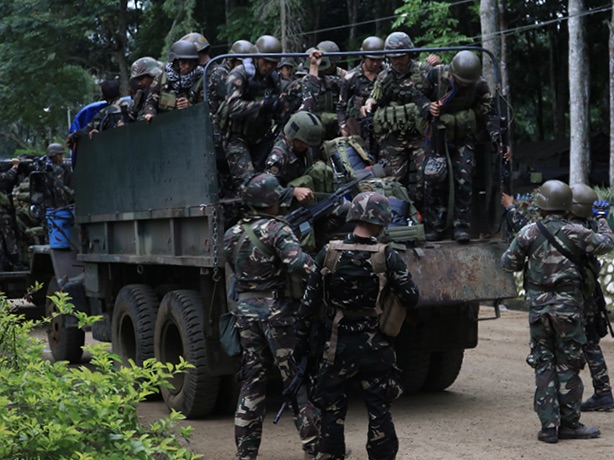
Filipino soldiers deploy during the Marawi siege. Photo: Philippines Information Agency.
His pledge was more so an attempt to gain legitimacy and funding from IS core rather than a demonstration of actual control. Funding was sparse, however, with only around USD 600,000 funneled by Mahmud Ahmad prior to the Marawi siege. Compared to the millions in ransom payments usually received by the ASG, external funding for Hapilon appeared unremarkable. VEOs acquire resources domestically through illicit economic activity such as extortion and kidnapping, as seen in the operations conducted by the ASG and DI-HG.
Arguably, Marawi was Hapilon’s last attempt to demonstrate control over a significant area in Mindanao. For five months, the fighting displaced hundreds of thousands of people and killed thousands of combatants on both sides. But contrary to views espoused by some foreign reporters and academics, the presence of foreign terrorist fighters (FTFs) who traveled on their own initiative—mostly from Indonesia and Malaysia—did not improve the combat skills of the local fighters.
As an example, the late Father Chito Suganob was the only Catholic priest based in Marawi when the fighting started. He spent 116 days in captivity and stated that he was “not impressed” by the FTFs.[10] He recalled seeing no more than a dozen FTFs performing mostly combat support tasks such as making Molotov cocktails and loading magazines. Southeast Asian FTFs would tell him that they were in Marawi to acquire combat experience. For AFP combatants, the experience of one special operations officer was one of surprise— finding only one fair-skinned, “foreign looking” cadaver.[11]
Instead, FTFs in Mindanao both before and after Marawi arrived piecemeal and mostly through their own self-funded trips. There are an estimated 20 FTFs based in Sulu and Maguindanao, split nearly evenly across the two provinces.[12] Once in-country, they have received differing receptions largely based on the needs of their host. In Sulu, Sahiron has refused to accommodate FTFs, considering them as liabilities and “magnets” for airstrikes. This has fueled tension with the more FTF-conducive Sawadjaan Group. A similar dynamic has played out among the DI factions in Maguindanao. Abu Turaype instructed DI-TG members to steer clear of FTFs, as the latter increases the possibility of raids by special operations forces.[13]
Another indicator of the limited links with overseas actors is the absence of imported improvised explosive device (IED) designs. Instead, IS-linked groups in the Philippines continue to proliferate local IED designs. Mindanao IEDs use main charges built either from ubiquitous dual-use materials such as fertilizers, or unexploded ordnance (UXO).
IED designs can be largely classified into examples found in the island provinces of Sulu and Basilan, and the Mindanao mainland. In Sulu, analysis of vests used in suicide attacks reveals the use of simple ammonium nitrate and fuel oil (ANFO) charges, which were packed into 4-inch segments of household plumbing used for hand faucets. Between 12-16 of these small charges were sewn into a handmade cloth vest and wired to a self-activated trigger.[14] In Basilan, ANFO is also the preferred material for IED main charges, but some ASG factions have sourced dynamite used for blast fishing from mainland Mindanao.[15]
In central Mindanao, large IEDs meant to target military convoys are often built from the cast-iron pump bodies filled with ANFO.[16] These are either scavenged from decrepit manual, hand-operated water pumps found in rural villages in Maguindanao, or bought new from spare parts dealers in urban areas. Other IEDs used for extortion often use black powder main charges or UXOs such as 81mm mortar shells.
Conclusion
Reporting on the influence of the Islamic State’s ideology on Philippine-based VEOs often glosses over the factionalism and local roots of this conflict. The various “Dawlah Islamiyah” groups did not emerge as direct offshoots of IS in Iraq and Syria. Groups in Mindanao predated IS and attaching the IS name to their organizations should be viewed more correctly as a branding exercise rather than an indicator of operational links.
The adage ‘all conflict is local’ is very apt in Mindanao. The Maute Group started as a private army by the Maute political clan. Their appropriation of the IS brand was meant to differentiate themselves from other private armies involved in election-related intimidation. The Dawlah and non-DI factions in Maguindanao were offshoots of the BIFF, which in turn splintered from the Moro Islamic Liberation Front as the latter pursued peace negotiations with Manila.
VEOs acquire illicit resources through criminal activity such as kidnapping and protection rackets. Some groups, especially those with greater access to government projects, engage in rent-seeking behavior rather than overt coercion. These include coopting relatives in government service to divert funds into a VEO’s coffers, as seen in the earlier years of the MG and the activities of the DI-TG. The combination of illicit economies and rent-seeking sustains VEO groups in Mindanao. Their persistence is therefore a result of a permissive milieu that incentivizes the continued use of armed activities to secure power and resources.
Given that the idea of IS-EA is aspirational rather than material, it would make better sense to address the quality-of-life issues that lead to the emergence of VEOs in the Philippines over investment in counter-ideological programs that will miss the mark. Contesting the narratives of an imagined “Dawlah Islamiyah” does not address the underlying socioeconomic conditions that lead individuals to join VEOs.
Endnotes
[1] See also Aymenn Jawad Al-Tamimi, “Observations on the new Islamic State video ‘Structure of the Caliphate’”, Aymenn Jawad Al-Tamimi’s Blog, 6 July 2016. http://www.aymennjawad.org/2016/07/observations-on-the-new-islamic-stat….
[2] Author screen capture of wanted poster published by the Philippine Army 12th CMO Battalion. https://www.facebook.com/DoseCmobattalion/photos/a.235402407239101/1078….
[3] Author field interviews with infantry officers based in Maguindanao province, March 2019.
[4] Author interview with intelligence officers based in Western Mindanao, November 2019.
[5] Author field interviews with intelligence officer based in Western Mindanao and academics based in Zamboanga City, November 2019.
[6] Author field interviews with infantry officers based in Central Mindanao, November 2019.
[7] Author field interviews with BARMM Members of Parliament and military officers in Cotabato City, November 2019.
[8] This was a sentiment expressed by various civil society, NGO, and military personnel interviewed by the author during field research in 2018 and 2019.
[9] Author field interviews with infantry officers based in Lanao del Sur, August 2018.
[10] Author field interview with Fr Chito Soganub in Cagayan De Oro City, August 2018.
[11] Author field interview with special operations unit officer in Marawi, August 2018.
[12] Author field interviews with civilian and military intelligence officers based in Cagayan de Oro City, Cotabato City, and Zamboanga City in November 2019. Additional interviews to triangulate FTF numbers with civil society leaders in Cotabato City in November 2019.
[13] Author field interviews with infantry officers based in Central Mindanao, November 2019.
[14] Author field interview with intelligence officer based in Zamboanga City, November 2019.
[15] Author field interview with civil society organization personnel based in Metro Manila, November 2019.
[16] Author field interviews with intelligence officer and EOD enlisted personnel in Cotabato City, November 2019.


